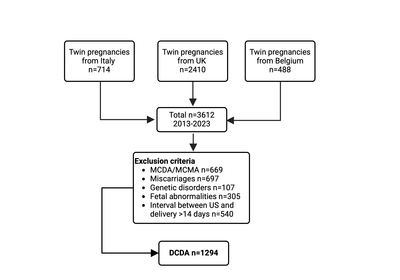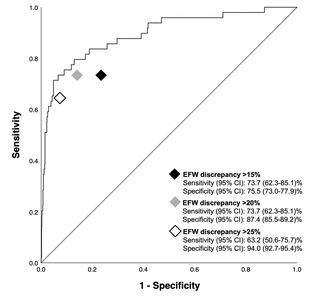Giorgione, V;
Trapani, M;
Brutto, M;
Ferrante, MG;
Bhide, A;
Jani, JC;
Badr, DA;
Ghi, T;
Thilaganathan, B;
Familiari, A;
et al.
Giorgione, V; Trapani, M; Brutto, M; Ferrante, MG; Bhide, A; Jani, JC; Badr, DA; Ghi, T; Thilaganathan, B; Familiari, A; Bevilacqua, E
(2025)
Predicting Adverse Perinatal Outcomes in Dichorionic Twin Pregnancies: A Multicentre Cohort Study.
BJOG: an International Journal of Obstetrics and Gynaecology, 132 (7).
pp. 983-990.
ISSN 1470-0328
https://doi.org/10.1111/1471-0528.18125
SGUL Authors: Thilaganathan, Baskaran
|
PDF
Published Version
Available under License Creative Commons Attribution. Download (427kB) |
||
|
Microsoft Word (.docx) (Data S1)
Supplemental Material
Download (29kB) |
||
![[img]](https://openaccess.sgul.ac.uk/117279/5.hassmallThumbnailVersion/bjo18125-sup-0002-figures1.jpeg)
|
Image (JPEG) (Figure S1)
Supplemental Material
Download (567kB) | Preview |
|
![[img]](https://openaccess.sgul.ac.uk/117279/11.hassmallThumbnailVersion/bjo18125-sup-0003-figures2.jpg)
|
Image (JPEG) (Figure S2)
Supplemental Material
Download (358kB) | Preview |
Abstract
Objective Dichorionic twin pregnancies are associated with increased risks of stillbirth or medically indicated early preterm birth (ePTB) to avoid stillbirths. This study evaluated the predictive value of fetal estimated weight (EFW) and Doppler indices before adverse perinatal outcomes. Design Retrospective multicentre cohort study. Setting Three tertiary centres in the UK, Italy and Belgium. Population The study included 1294 dichorionic twin pregnancies managed between 2013 and 2023. Methods Univariable and multivariable analyses assessed the association and the predictive accuracy between EFW and Doppler indices taken within 2 weeks of birth or adverse perinatal outcomes. Main Outcome Measures Stillbirths (of one or both twins) or medically indicated ePTB before 34 weeks' gestation for fetal indications. Results The study identified 58 pregnancies (4.5%) complicated by adverse perinatal outcomes. There were significant differences (all p < 0.001) between twins with adverse perinatal outcomes and liveborn twins for small for gestational age foetuses (89.5% vs. 59.3%), EFW discordance (31.8% vs. 8.4%), umbilical artery (UA) pulsatility index (PI) discordance (39.7% vs. 12.6%) and middle cerebral artery PI discordance (27.6% vs. 13.3%). These associations remained significant after adjusting for maternal characteristics and gestational age. The best predictive model included EFW discordance and UA PI discordance, with an area under the curve of 0.90. Conclusions The integration of intertwin EFW and UA PI discordance can effectively predict stillbirths or the need for medically indicated ePTB. After external validation in larger populations, this model could provide effective risk stratification of dichorionic pregnancies to enable targeted interventions to improve clinical outcomes.
| Item Type: | Article | ||||||||
|---|---|---|---|---|---|---|---|---|---|
| Additional Information: | © 2025 The Author(s). BJOG: An International Journal of Obstetrics and Gynaecology published by John Wiley & Sons Ltd. This is an open access article under the terms of the Creative Commons Attribution License (http://creativecommons.org/licenses/by/4.0/), which permits use, distribution and reproduction in any medium, provided the original work is properly cited. | ||||||||
| Keywords: | 11 Medical and Health Sciences, Obstetrics & Reproductive Medicine | ||||||||
| SGUL Research Institute / Research Centre: | Academic Structure > Cardiovascular & Genomics Research Institute Academic Structure > Cardiovascular & Genomics Research Institute > Vascular Biology |
||||||||
| Journal or Publication Title: | BJOG: an International Journal of Obstetrics and Gynaecology | ||||||||
| ISSN: | 1470-0328 | ||||||||
| Publisher License: | Creative Commons: Attribution 4.0 | ||||||||
| Dates: |
|
||||||||
| URI: | https://openaccess.sgul.ac.uk/id/eprint/117279 | ||||||||
| Publisher's version: | https://doi.org/10.1111/1471-0528.18125 |
Statistics
Actions (login required)
 |
Edit Item |



